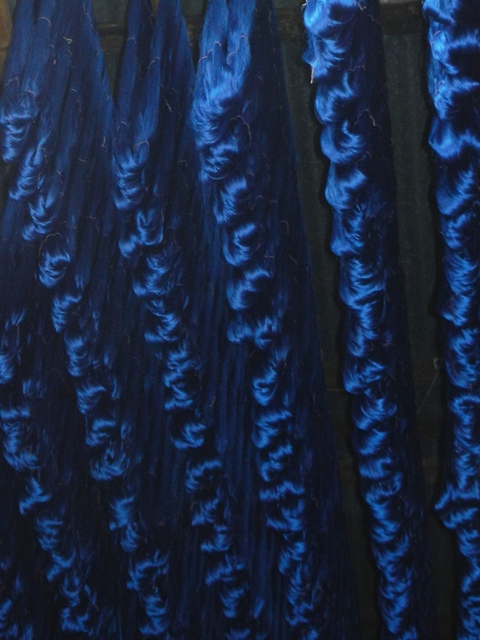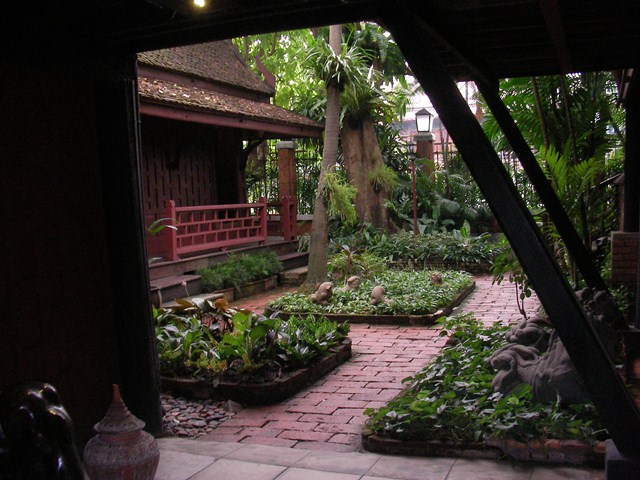
Saen Saeb Canal
Most people who enjoy heritage and beauty visit Jim Thompson’s house in Bangkok but few are aware that they can still see the traditional art of silk dyeing and weaving nearby. Brian Walling goes on the trail of the last silk weavers of the Thai capital.
Hidden away in Bangkok’s centre is a gem unknown to almost all visitors: the last two remaining workshops of the original silk-weaving community brought to prominence by the legendary founder of the Thai silk ‘industry’, Jim Thompson, in the 1950s and 1960s. Visitors are welcome and can experience the whole process of silk weaving. It’s also possible to buy beautiful examples of Thai silk craft articles at workshop prices.
Around 200 metres on foot from the Jim Thompson House and Museum (one of Bangkok’s best-known visitor attractions) the small village of the original silk weaver community, where the two last workshops are situated, is easy to find. It should be of interest to many expats living in Malaysia who would like something a little different to do when they visit Bangkok.
Turn left upon exiting the Jim Thompson House site, left again onto the canal-side (Klong Saen Saeb) walkway and head west. After 130 metres cross footbridge to north side of canal and continue left (west) along canal-side for about 25 metres. Turn right into the narrow Soi (Lane) 9, marked by a signpost in Thai but with a figure 9 visible. There is also a new information panel in English & Thai about the silk weaving on the canal-side opposite Soi 9. The first workshop (Aood Baan Krua Thai Silk) is just a few houses into the Soi on the left side; the second (Phamai Baan Krua) is further into the Soi. The pictures here are from the first of the workshops.
The traditions of Thai Silk
The two surviving family businesses gladly welcome visitors inside (English is spoken) and are happy to explain the silk fabric production process. A good selection of clothing and decoration items in silk is usually available for sale at very reasonable prices.
Most impressive is the completely manual, artisan nature of the process, from the production of the yarn through to the dyeing and weaving stages. The process starts with the huge open dyeing vats sitting on top of their wood-fired ovens. Then the hanks of silk yarn are hung in the roof space to dry. When those processes are complete, the silk is woven on a traditional handloom. All this takes place within a wooden building which also serves as family home.
One factor making the Baan Krua silk a winner in spearheading the international success of Thai silk was the fact that it has unique characteristics and is distinguished by a glossy appearance, due to the unique dyeing process which produces shiny thread without the use of chemicals. The thread is switched back and forth during this part of the process, ensuring the colour is equally distributed across the whole length. The temperature of the water used, which must be boiling, is also critical to ensuring that the silk thread appears glossy.
Jim Thompson’s involvement in the Silk Industry

Historically, the silk weaving community in this village is some 200 years old. It dates back to the late 1700s, when King Rama I (reigning 1782-1809) generously provided some land to Cham Muslim migrants from the region of today’s Cambodia and Vietnam, who brought with them to Thailand their silk weaving skills. They produced silk sarongs for their domestic use but also traded these along the nearby Chao Phraya River into other cities and provinces.
Jim Thompson, the legendary American who is credited with placing the Thai silk industry on the international stage, was introduced to these weavers by the Thai Royal Family after the Second World War and during the relatively brief period of 1948 to 1967 helped them to modernise with new dyes, equipment and weaving techniques. These weavers became the productive backbone of the Jim Thompson Thai Silk Company. Thompson built his own house (now a museum) just across the canal from the village.
After Thompson mysteriously disappeared without any trace in 1967 on a trip to Malaysia’s Cameron Highlands, his successors in the silk company wound down the company’s involvement with the Baan Krua village weavers and moved the production to factory operations outside Bangkok. The Baan Krua weavers lost their major outlet and, with the declining interest of their young people in learning the manual silk-work processes, it progressively led to today’s situation where only a very small residue of the original village industry survives.
This whole area is, incidentally, prime cat territory – watch for them. The footbridge across the Saen Saeb canal is usually guarded at its southern end by a demanding ginger one. The silk works also has its own friendly cat.
Jim Thompson’s House on the Klong

Jim Thompson had a colourful life, as an architect, an army officer, a spy, a businessman, and a collector. Born in 1906, he settled in Bangkok after the end of the Second World War, and set up a silk business which flourishes to this day.
He also constructed an extraordinary home by one of Bangkok’s klongs, or canals. In the heart of the city, it consists of six interlinked wooden houses set on stilts amidst dreamy tropical gardens. Because traditional Thai houses are constructed without nails, they are comparatively easy to take down and move to a different location. The houses themselves came from various locations all over Thailand and were re-assembled on the new site. After the house was completed in 1959, it became a focus for legendary entertaining.
The central salon is an airy room with shuttered windows which open to catch any passing breeze while the two bedrooms (one for Jim Thompson and one for a guest) are more protected and private rooms. An amazing collection of Siamese and Khmer antique furniture, paintings and objects d’art makes the house a place a “must see” on any trip to Bangkok.
Homepage Highlight Photo credit: Rajesh_India / Foter / Creative Commons Attribution-NonCommercial-NoDerivs 2.0 Generic (CC BY-NC-ND 2.0)
Source: Penang International April/May 2014
Read more:
- 5 Expats Learn to Survive Penang’s Traffic and Parking
- Sailing Around Penang with Three Expats in a Small Boat
- The Art of Nyonya Cuisine in Penang
What are your thoughts on this article? Let us know by commenting below.No registration needed.
"ExpatGo welcomes and encourages comments, input, and divergent opinions. However, we kindly request that you use suitable language in your comments, and refrain from any sort of personal attack, hate speech, or disparaging rhetoric. Comments not in line with this are subject to removal from the site. "




















